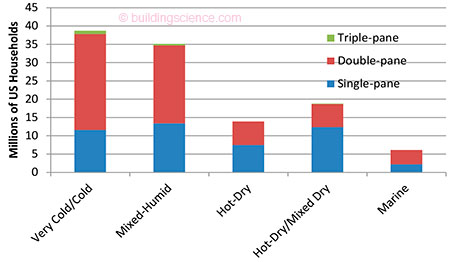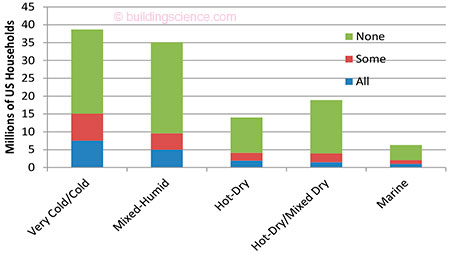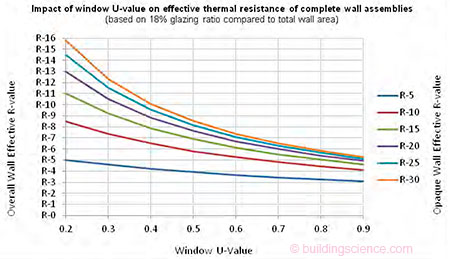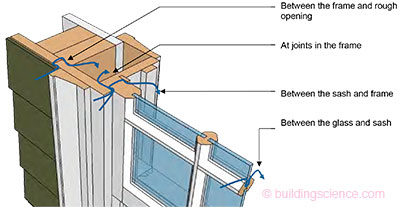There is a significant push for energy performance upgrades to existing homes. An important target is often the windows. Old single-glazed windows have such low thermal resistance that their effect on the overall thermal resistance of the walls can be staggering. Improving the performance of the window stock is therefore central to the goal of reducing the energy consumption of the existing building stock. This measure guideline provides information and guidance about rehabilitating, retrofitting, and replacing wood window assemblies in residential construction. It is intended primarily to help contractors and homeowners understand the options for safely improving the performance of their wood windows.
Executive Summary
There is a significant push for energy performance upgrades to existing homes. An important target is often the windows. Old single-glazed windows have such low thermal resistance that their effect on the overall thermal resistance of the walls can be staggering. Improving the performance of the window stock is therefore central to the goal of reducing the energy consumption of the existing building stock.
This measure guideline provides information and guidance about rehabilitating, retrofitting, and replacing wood window assemblies in residential construction. It is intended primarily to help contractors and homeowners understand the options for safely improving the performance of their wood windows.
Deciding which window measure will be most appropriate for the retrofit project depends on several factors, including current conditions, desired appearance or aesthetic goals, energy performance goals, cost, disruption to occupants, durability risks, historic requirements, and any other project goals or requirements.
Table 1 lists the f most common approaches to improve the performance of wood windows:
Table 1. Window Retrofit Measures
| Measure | Description | |
| 1 | Window rehabilitation | Repair/rehabilitation of the old window sashes, leaving the original wood window frame in place. Frame and sash rehabilitation to improve water management and air infiltration performance. Does not improve conductance or solar gain. Cost can be highly variable depending on window condition and extent of work needed. |
| 2 | Exterior storm windows | Recommended installation practice for exterior storm windows, including preparation of windows to accommodate storm windows. Improves the air infiltration performance, conductance, and solar gain. Additional benefits can be achieved with hard coat low-e glazing. Cost is relatively low. |
| 3 | Interior removable storm windows | Recommended installation practice for removable interior storm windows, including preparation of windows to accommodate storm windows. Improves the air infiltration performance, conductance, and solar gain. Condensation potential on outer prime window could be a durability concern. Cost is relatively low. |
| 4 | Interior permanent storm windows | Recommended installation practice for permanent interior storm windows, including preparation of windows to accommodate storm windows. Improves the air infiltration performance, conductance, and solar gain. Condensation potential on outer prime window could be a durability concern. Cost is moderate to high compared to other measures, depending on options chosen. |
| 5 | Window sash modification | Modification of the old window sashes, leaving the original wood window frames in place. Frame preparation to accommodate original sashes to accept high performance insulating glass units. Improves the air infiltration performance, conductance, and solar gain and maintains the original appearance of the windows. Cost can be moderate to high compared to other retrofit measures. |
| 6 | Window sash replacement | Removal of the old window sashes, leaving the original wood window frames in place. Frame preparation to accommodate high performance replacement sashes and tracks. Improves the air infiltration performance, conductance, and solar gain and maintains a similar appearance of the windows. Cost can be moderate to high compared to other retrofit measures. |
| 7 | Insert replacement window | Removal of the old window sashes and reconfiguration of window frame to accommodate a replacement window installed in the wood window frame. Improves the air infiltration performance, conductance, and solar gain. Work can be done quickly with little disruption to the occupants. Cost can be moderate to high compared to other retrofit measures, depending on performance of replacement window chosen. |
| 8 | Complete window replacement | Removal of the old window, including frame, and reconfiguration of the rough opening to accommodate a new high performance window following current recommended water management installation techniques. Improves the air infiltration performance, conductance, and solar gain. Provides the most control over the window size, location, placement, and integration with other enclosure retrofit measures. Cost is high compared to other retrofit measures and is typically a significant disruption to the building occupant. |
Complementary information about a variety of energy upgrades can also be found in the National Renewable Energy Laboratory’s Standard Work Specifications, currently under development through U.S. Department of Energy’s Guidelines for Homes Energy Professionals project.
1 Introduction
There is a significant push for energy performance upgrades to existing homes. An important target is often the windows. Poor window performance can have significant impacts on the overall thermal resistance and airtightness of the home. The existing U.S. housing stock has a wide range of window types (Figure 1), ages, and conditions. All are factors in the overall energy performance and comfort performance of the home. Most windows are still original to the
homes; however, it is not uncommon for windows to be replaced (Figure 2). Possibly more common than window replacement are attempts at lower cost window retrofits. These retrofits have often been done (with varying degrees of success) by homeowners trying to address problems without adequate knowledge about how to safely, effectively, and economically address the problems.
Figure 1: Glazing type (single, double, triple) by climate region (EIA 2009)
Figure 2: Window replacement history by climate region (EIA 2009)
Old single-glazed windows have such low thermal resistance that their effect on the overall thermal resistance of the walls can be staggering. A simple UA1 analysis that compares the total wall effective R-value to the window U-value for opaque wall assemblies of varying effective Rvalues shows how significant this impact can be (Figure 3).
Figure 3: Impact of window U-value on effective thermal resistance of complete wall assemblies
Older windows typically represent a significant portion of the total house air infiltration. The combined effect of poor thermal performance and air infiltration results in windows being a major component to total energy use. Improving the performance of the window stock is therefore central to the goal of reducing the energy consumption of the existing building stock.
Table 2 provides information and guidance about rehabilitating, retrofitting, and replacing wood window assemblies in residential construction. The intent is to provide information about means and methods to improve the energy and comfort performance of wood window assemblies in a way that considers component durability, in-service operation, and long-term performance. This guideline focuses on proper detailing of strategies to provide a visual reference for how to properly implement these recommendations.
This measure guideline is primarily intended to help contractors and homeowners understand the options for safely improving the performance of their wood windows. The details are simple, clear, and provide specific information about building condition review, material preparation, installation, and other considerations that would not normally be explained in a general retrofit recommendation.
Table 2: Window Performance Improvement Measures
| Measure | Description | |
| 1 | Window rehabilitation | Repair/rehabilitation of the old window sashes, leaving the original wood window frames in place. Frame and sash rehabilitation to improve water management and air infiltration performance. |
| 2 | Exterior storm windows | Recommended installation practice for exterior storm windows, including preparation of windows to accommodate storm windows. |
| 3 | Interior removable storm windows | Recommended installation practice for removable interior storm windows, including preparation of windows to accommodate storm windows. |
| 4 | Interior permanent storm windows | Recommended installation practice for permanent interior storm windows, including preparation of windows to accommodate storm windows. |
| 5 | Window sash modification | Modification of the old window sashes, leaving the original wood window frames in place. Frame preparation to accommodate original sashes to accept high performance insulating glass units (IGUs). |
| 6 | Window sash | Removal of the old window sashes, leaving the original wood window frames in place. Frame preparation to accommodate high performance replacement sashes and tracks. |
| 7 | Insert replacement window | Removal of the old window sashes and reconfiguration of window frames to accommodate replacement windows installed in the wood window frames. |
| 8 | Complete window replacement | Removal of the old window, including frame, and reconfiguration of the rough opening to accommodate a new high performance window, following current recommended water management installation techniques. |
Do-it-yourself homeowners (as opposed to professional contractors) are likely to use this information: therefore, it is important that clear information about means and methods be provided, so that retrofits can be executed in a manner which will promote long term durability of the building enclosure systems.
Complementary information about a variety of energy upgrades can also be found in the National Renewable Energy Laboratory’s (NREL) Standard Work Specifications, currently under development through the U.S. Department of Energy’s (DOE) Guidelines for Homes Energy Professionals project.
2 Decision-Making Criteria
2.1 Risk Identification
Before any retrofit work is conducted, the conditions of the building systems must be reviewed.
2.1.1 Lead and Other Hazardous Materials
Lead is commonly located on old wood windows and trim. Any work being completed on the window systems should follow all state and federal laws for handling hazardous materials.
2.1.2 Site Conditions and Project Staging
The home and site should be reviewed to identify impacts and risks associated with completing the work.
Scaffolding, lifts, ladders, or other means to access work areas may be needed if the work is to be done on the exterior. Work done at height may require fall protection. Proximity to adjacent property or vegetation may limit access or create unsafe work areas. Exterior staged work may also damage landscaping or vegetation. If the work will be done from the interior, consideration should be given to disruptions to the occupants and clearances for moving equipment and materials into and out of the space. Interior work always poses a risk of damage to interior finishes. Planning and protection are required.
2.1.3 Identification of Water Infiltration Concerns
Windows are the most common location of water infiltration issues. It is important to understand the various pathways for potential water infiltration, and identify current water leakage problems. Although the details presented in this guideline are all intended to improve the moisture performance of the window assemblies, the guideline is not intended to address all possibilities, and is not a replacement for inspection and evaluation of the performance of an individual window. Problems should be identified, and the strategy chosen that will be most appropriate to address the concern. Window systems water leaks can be grouped in four general categories (Figure 4):
- Between the window frame and rough opening
- Through the joints in the window frame
- Between the window frame and the operable sashes
- Through the joints between the glass and the sash frames.
Figure 4: Common window water infiltration pathways
Interior and exterior inspection and monitoring of the building conditions should be completed before any work is started. Water staining, peeling paint or wall paper, and staining on trim or floor assemblies below window systems indicate water infiltration and/or condensation. Leakage between the sashes and the frame and between the glass and the sash is usually marked by water staining on the interior window frame. Condensation on the window frames can also lead to staining of the interior finishes. It is important to monitor the questionable area to prevent a false diagnosis of the water management problem.
Leakage between the window and the rough opening or through the joints in the window are typically contained within the wall assembly and may go unnoticed, or could manifest as staining and peeling paint below the window or damaged flooring.
Other problems such as water infiltration at the window head may be indications of failed or missing head flashing. However, other problems not associated with the window system may cause the water infiltration. Care must be taken to properly diagnose the infiltration pathway.
If it is a known recurring problem, the infiltration problem must be addressed prior to, or in conjunction with, the window retrofit work.
If there are no obvious signs of water infiltration problems and the window elements and connection wall components are in good condition, no additional work may be needed. However, water infiltration problems are often concealed within wall cavities. This becomes a greater concern if the window retrofit work is being done in conjunction with the addition of cavity fill insulation, because a cavity that may have had sufficient drying ability may now have prolonged
moisture accumulation that can lead to material deterioration. If leakage is suspected, further investigation, including thermal scans, moisture content measurements, and cutting of investigation holes below window assemblies to look for signs of moisture problems are recommended.
Unless the problem is obvious, it may be prudent to contact someone with experience diagnosing water infiltration problems before proceeding.
2.1.4 Identification of Deteriorated or Damaged Materials
Damaged materials should be removed and replaced as part of the retrofit. Certain elements will be more critical to the proper implementation of the chosen strategy.
The window sill is arguably the most important element of the window assembly, as water will drain downward by gravity either into the wall (e.g., hole through sill) or directly onto the wall (failure of the sill extension). For all proposed measures in this guideline (except complete window replacement), the condition of the sill is critical to the performance of the measure. Cracked or rotting sills need to be replaced before any work is done (see Figure 5).
Figure 5: Failed window sill with replacement window installed
The window frame, including the exterior casings, is the next most critical element. If the casing is deteriorating, its replacement may be warranted. This should not be confused with the exterior trim, which is often installed as a decorative element on top of the casing. Deteriorating trim may not affect the water management performance of the window; however, it may be an indication of other problems and generally creates an aesthetic problem.
Depending on the measure being examined, the condition of the window sashes may or may not be a concern to the performance of the measure. For window rehabilitation, sash retrofit, or interior storm window retrofit, the condition of the sashes is critical to the performance of the window. For exterior storm windows, the sashes are more protected from the elements, and the condition is less important from a water management perspective, yet still critical from an energy and condensation resistance perspective. For sash replacement, window insert, or full window replacement, the condition of the sash is irrelevant, as they will be removed. Thus, windows with severely deteriorated sashes may be better candidates for the latter retrofit measures. . .
Download complete report here.
Footnotes:





